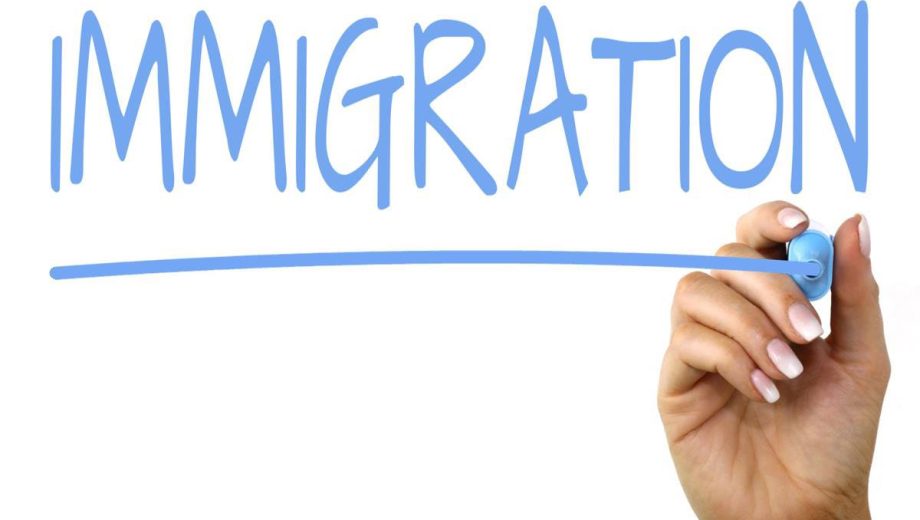
NEWSLETTER DECEMBER 2024
What's In This Issue?
In this issue, we delve into the history of citizenship and its connection to voting rights. Additionally, we introduce a new section highlighting immigrants who have made significant contributions to science and the arts.
BIRTHRIGHT CITIZENSHIP AND WHY IT MATTERS
Who gets to be a US citizen? What benefit is there to being a U.S. citizen? Should anyone born in the United States be entitled to automatic citizenship? These questions have been debated since the establishment of the American colonies. It is worth understanding the history of the citizenship process in the U.S. and its link to voting rights. It is especially important now, when the debate about birthright citizenship is in the forefront of the news cycle. This article attempts to provide some context on the history of citizenship, its link to voting rights, and the underlying reasons why some may want to put a stop to birthright citizenship.
The rules of the game
The issue of U.S. citizenship is as complex as the history of the United States. When British settlers came to colonize what we now know as the “United States”, it was not united and there were no states. Indigenous people already lived in the colonies, and parts of the country were under the control of other European powers such as Spain and France. Through wars, negotiations and displacing of natives, a new nation was born. The founders of this new nation where land owning white men. In order to maintain political and social control, a framework for the fledgling nation was necessary. This entailed establishing the criteria for citizenship in this emerging nation and outlining the procedures foreign nationals needed to follow to obtain it.
The first rules regarding naturalization were implemented by U.S. Congress on March 26, 1790 via the Naturalization Act. This Act provided that any free, white, adult alien male (or female), of good moral character, residing within the jurisdictional limits of the United States for two years, was eligible for citizenship. At the time, the application for citizenship could be processed by any common law court, and children under age 21 whose parents became naturalized citizens, would automatically become citizens themselves. [1] In 1795 Congress amended the naturalization laws, requiring an applicant to declare their intention of becoming a citizen three years before naturalization, with a five-year minimum residence requirement. In 1798, the Alien and Seditions Act was passed by Congress. The Act modified citizenship procedures by requiring foreign nationals to declare the intent of becoming a citizen five years before applying and extending the minimum residence requirement to fourteen years. The Act also barred any foreign national from a country at war with the United States from applying for citizenship. In 1802 congress repealed these rules and reinstated the three-year declaration period and the five-year residency requirement. [2]
The 14th Amendment and birthright citizenship
While there was a path to citizenship for foreign nationals and it was accepted that the descendants of white European settlers were granted citizenship by birthright in the States, Native Americans and former slaves were entirely excluded from this process. Additionally, there was nothing in the framework of the U.S. Constitution confirming birthright citizenship. It was not until 1868, (three years after the abolishment of slavery), that the 14th Amendment was ratified, providing for due process and equal protection under the law, along with birthright citizenship to anyone “born or naturalized in the United States, and subject to the jurisdiction thereof.”[3]
Thanks to the 14th Amendment, former slaves and their descendants were granted the same constitutional rights as white Americans, including the right to vote (though this was limited to black men, as women’s suffrage was not included in the U.S. Constitution until the 19th Amendment in August 1920). [4] Following the 14th Amendment, the 15th Amendment was added to the Constitution to ensure that voters would not face discrimination based on race, color, or previous condition of servitude.
Lack of state compliance
Despite the constitutional amendments, states continued to engage in discriminatory practices to disenfranchise former slaves. These measures included poll taxes (a pay-to-play system that made it difficult for people of little means—both black and white—to vote), literacy tests (in Mississippi, voters had to read a portion of the state constitution and explain it to the county clerk, who would then determine if the voter was literate), racial gerrymandering (drawing voting district maps to ensure that whites would win every district), intimidation through threats from white employers and white supremacist organizations, and, when all else failed, lynching. [5] Similar steps were taken against Native Americans.
Native Americans were not given citizenship until June 2, 1924, (over fifty years after the ratification of the 14th Amendment) through the Indian Citizenship Act. [6] While the Act was designed to provide Native Americans with citizenship, it did little to secure their right to vote. Native Americans had to (and continue to) fight many obstacles implemented by the states to shut out their voices. States such as Arizona, New Mexico and Utah, held the position that Native Americans living in reservations did not have the right to vote because they did not pay state taxes or because they were wards of the federal government. [7]
The Civil Rights movement forces change
Following the murder of three young voting rights advocates in Mississippi in 1964,[8] and a brutal attack by the Alabama state police on peaceful civil rights protestors in March of 1965, [9] U.S. Congress was compelled to take action. This led to the creation of the Voting Rights Act of 1965, aimed at protecting black and brown voters in states where discriminatory voting practices were prevalent.
One of the key elements of the Act was the pre-clearance process. [10] This process required states with a history of discriminatory voting practices, to get federal approval before making changes to their voting rules. This pre-clearance process was critical to ensuring that states did not continue creating roadblocks to voting rights of already marginalized communities. However, over time, the Voting Rights Act has been gradually weakened through litigation initiated by the very states that openly discriminated against black and brown voters.
The walking back of the Voting Rights Act
In 2013, Shelby County, Alabama won a challenge to the pre-clearance process of the Voting Rights Act. Shelby County argued that the methodology used to determine which localities were subject to the pre-clearance process was outdated and there was no longer the racial disparity that once necessitated the process. The Supreme Court agreed with Shelby County and invalidated the coverage formula created through the Act. [11] As a direct result of this decision, no states are currently required to get federal approval for changes to election rules.
In 2021, the Supreme Court dealt another blow to the Voting Rights Act by siding with Arizona in a challenge against the state’s voting practices. The Court upheld Arizona’s policies of discarding votes cast outside a voter’s precinct and criminalizing the collection and delivery of another person’s ballot, deeming them appropriate and non-discriminatory.[12] These rules have a well-documented discriminatory impact on Native American citizens within Arizona, despite this, the Supreme Court upheld them.
Carnegie Mellon University, along with the Brennan Center for Justice have been studying the trends in states voting regulations post the Shelby County decision in 2013. The trend is demonstrating that states are making voting more difficult through various means such as limiting drop box locations, reducing hours at polling places and harsher ID requirements. These changes tend to impact the elderly and marginalized communities. [13]
Lessons we can glean
The many obstacles placed on access to citizenship imply that the ultimate target is the right to vote, not just citizenship itself. This point cannot be overstated. It took several amendments to the U.S. Constitution, Congressional intervention, legal battles, and an entire civil rights movement to provide black and brown individuals with not just citizenship but access to the political process. Additionally, the uphill battle for women’s voting rights exposes the deep-seated racism and sexism that are undeniable parts of the underlying fabric of the United States. Understanding the effort it took to achieve these rights helps us appreciate their value.
With the immigrant population in the United States evolving from mainly white Europeans to black and brown individuals from around the globe, it’s no surprise that birthright citizenship has come into focus. Racist elements, anxious about losing their political influence, are stoking discontent towards immigrants, using fear and manipulation to retain their control. Can the U.S. Constitution help guide the discussion?
The U.S. Constitution is just over 236 years old, and the Fourteenth Amendment 156 years old. It is a relatively young guiding document of a relatively young nation. A challenge to the Fourteenth Amendment is possible. However, the U.S. Supreme Court has historically upheld birthright citizenship, most notably in the 1898 case of United States v. Wong Kim Ark.[14] In a 6-2 decision, the Court affirmed that anyone born in the U.S. is a citizen, regardless of their parents’ status. If the issue were raised again and the Supreme Court granted certiorari, the outcome would depend on the Court’s interpretation of the Fourteenth Amendment this time around. It is an important topic that this journal will continue to monitor.
IMMIGRANT PROFILES
In this new segment of our newsletter, we will explore immigrants who made important contributions to the U.S. in the fields of science and the arts.
This month’s immigrant profile focuses on Elisabeth Stern (1915-1980).

Elizabeth Stern, was a Canadian born pathologist who became a U.S. citizen in 1943. She was professor of epidemiology at the University of California in 1963, and one of the first researchers to specialize in the study of diseased cells.
Her research into the link between herpes simplex and cervical cancer is thought to be the first case study linking a specific virus to a specific type of cancer. She was also the first to link oral contraceptives to cervical cancer. Her work has been important in enabling earlier cancer detection and treatment. [15]
Thanks to Stern’s research many women’s lives have been saved.
WHATS NEXT?
JANUARY 2025 ISSUE
In January this journal will explore:
- The H visa category, its complex path and future challenges.
- Investor visas, the good and the bad.
- Immigrant Profiles – Mario Jose Molina, Physicist
[1] Bolger, Eilleen (December 10. 2024), Naturalization Process in U.S.: Early History, VCU Social Welfare History Project, https://socialwelfare.library.vcu.edu/federal/naturalization-process-in-u-s-early-history
[2] Bolger, Eilleen (December 10. 2024), Naturalization Process in U.S.: Early History, VCU Social Welfare History Project, https://socialwelfare.library.vcu.edu/federal/naturalization-process-in-u-s-early-history
[3] National Archives, https://www.archives.gov/milestone-documents/14th-amendment
[4] National Museum of African American History and Culture, Smithsonian, Make Good the Promises, Reconstructing Citizenship (December 5, 2024) https://nmaahc.si.edu/explore/exhibitions/make-good-promises
[5] BRIA 12 2 b Race and Voting in the Segregated South. Teach Democracy. (December 2024) https://teachdemocracy.org/bill-of-rights-in-action/bria-12-2-b-race-and-voting-in-the-segregated-south
[6] The Indian Citizenship Act at 100 Years Old, (June 4, 2024) (This article originally appeared in the NARF Legal Review, Vol #49 No. 1), https://narf.org/the-indian-citizenship-act-at-100-years-old/
[7] Friel, Katie, Pablo, Emil Mella, How Voter Suppression Laws Target Native Americans, May 23, 2022, https://www.brennancenter.org/our-work/research-reports/how-voter-suppression-laws-target-native-americans
[8] Jones, Ryan M., (December 2024) Mississippi Burning: From Murder Mayhem to a Mighty Mission, https://www.civilrightsmuseum.org/news/posts/mississippi-burning-from-murder-mayhem-to-a-mighty-mission
[9] Crayton, Kareem, (July 17, 2023), The Voting Rights Act Explained | Brennan Center for Justice, https://www.brennancenter.org/our-work/research-reports/voting-rights-act-explained
[10] Ibid.
[11] Li, Michael, (March 11, 2024), Preclearance Under the Voting Rights Act, Brennan Center for Justice, https://www.brennancenter.org/our-work/research-reports/preclearance-under-voting-rights-act
[12] Totenberg, Nina (July 21, 2021), The Supreme Court Deals A New Blow To Voting Rights, Upholding Arizona Restrictions, https://www.npr.org/2021/07/01/998758022/the-supreme-court-upheld-upholds-arizona-measures-that-restrict-voting
[13] Folts, Emma, (October 2024), States have passed laws that make voting harder. Heinz alumna Chelsea Jones uses data to advocate for reform, https://www.heinz.cmu.edu/media/2024/
[14] United States v. Wong Kim Ark (1898) https://constitutioncenter.org/the-constitution/supreme-court-case-library/united-states-v-wong-kim-ark-1898
[15] Weisberger, Mindy (February 7, 2017), 11 Immigrant Scientists Who Made Great Contributions to America, https://www.livescience.com/57769-immigrants-who-shaped-science.html
